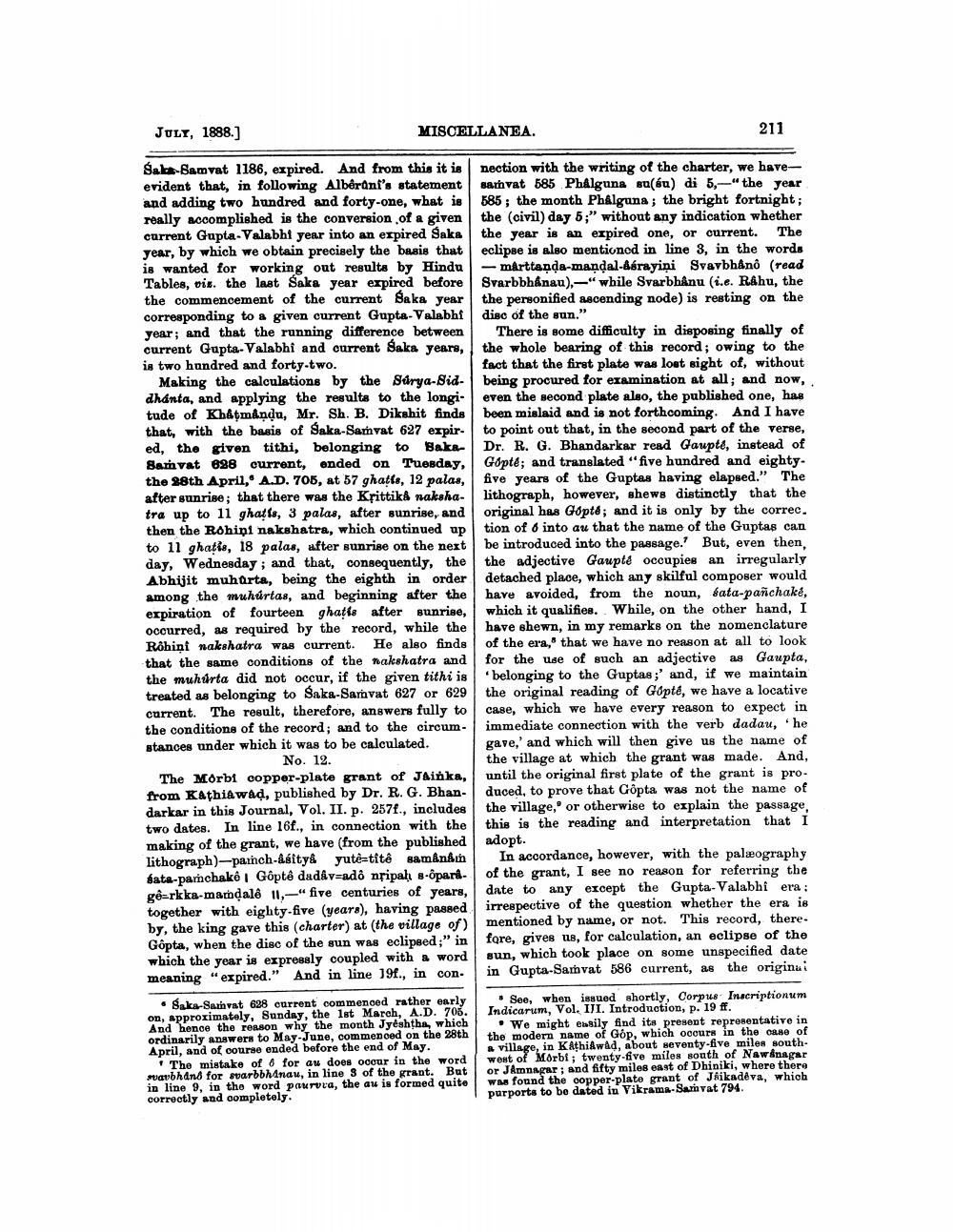________________
JULY, 1888.]
MISCELLANEA.
211
Sal-Samvat 1186, expired. And from this it is nection with the writing of the charter, we haveevident that, in following Alberoni's statement | samvat 585 PhAlguna su(su) di 5,-"the year and adding two hundred and forty-one, what is 585; the month Phálguna; the bright fortnight; really accomplished is the conversion of a given the (civil) day 5;" without any indication whether current Gupta- Valabht year into an expired Saka the year is an expired one, or current. The year, by which we obtain precisely the basis that eclipse is also mentioned in line 3, in the words is wanted for working out results by Hindu -marttanda-mandal-Asrayiņi Svavbhânô (read Tables, vis. the last Saka year expired before Svarbbhanau)," while Svarbhanu (i.e. Rahu, the the commencement of the current Saka year the personified ascending node) is resting on the corresponding to a given current Gupta- Valabhi disc of the sun." year; and that the running difference between There is some difficulty in disposing finally of current Gupta- Valabhi and current Saka years, the whole bearing of this record; owing to the is two hundred and forty-two.
fact that the first plate was lost sight of, without Making the calculations by the Sürya-Sid- being procured for examination at all; and now, dhanta, and applying the results to the longi- even the second plate also, the published one, has tude of Khâțmandu, Mr. Sh. B. Dikshit finds been mislaid and is not forthcoming. And I have that, with the basis of Saka-Samvat 627 expir. to point out that, in the second part of the verse, ed, the given tithi, belonging to Bake- Dr. R. G. Bhandarkar read Gaupte, instead of Samvat 628 current, ended on Tuesday, Gøpté; and translated “five hundred and eighty. the 28th April, A.D. 705, at 57 ghatis, 12 palas, five years of the Guptas having elapsed." The after sunrise; that there was the Ksittika naksha- lithograph, however, shews distinctly that the tra up to 11 ghatis, 3 palas, after sunrise, and original has Gopté ; and it is only by the correc. then the Rohiņi nakshatra, which continued up tion of 6 into au that the name of the Guptas can to 11 ghatis, 18 palas, after sunrise on the next be introduced into the passage. But, even then, day, Wednesday; and that, consequently, the the adjective Gaupte occupies an irregularly Abhijit muharta, being the eighth in order detached place, which any skilful composer would among the muhúrtas, and beginning after the have avoided, from the noun, tata-pañchake, expiration of fourteen ghatis after sunrise, which it qualifies. While, on the other hand, I occurred, as required by the record, while the have shewn, in my remarks on the nomenclature Rôhiņi nakshatra was current. He also finds of the era," that we have no reason at all to look that the same conditions of the nakshatra and for the use of such an adjective as Gaupta, the muhurta did not occur, if the given tithi is belonging to the Guptas ;' and, if we maintain treated as belonging to Saka-Samvat 627 or 629 the original reading of Gopté, we have a locative current. The result, therefore, answers fully to case, which we have every reason to expect in the conditions of the record; and to the circum- immediate connection with the verb dadau, he stanoes under which it was to be calculated. gave,' and which will then give us the name of No. 12.
the village at which the grant was made. And, The Morbi copper-plate grant of Jainka, until the original first plate of the grant is profrom Kathiawad, published by Dr. R. G. Bhan. duced, to prove that Göpta was not the name of darkar in this Journal, Vol. II. p. 257f., includes the village, or otherwise to explain the passage, two dates. In line 16f., in connection with the this is the reading and interpretation that I making of the grant, we have (from the published adopt. lithograph)-painch-Asity yute=tite samanan In accordance, however, with the palæography data-parnchake | Gôptê dad&v=ado nipah s-ôpara. of the grant, I see no reason for referring the gê=rkka-mamdalê 11,4" five centuries of years, date to any except the Gupta-Valabhi era: together with eighty-five (years), having passed irrespective of the question whether the era is by, the king gave this (charter) at (the village of) mentioned by name, or not. This record, there. Gôpta, when the disc of the sun was eclipsed;" in fore, gives us, for calculation, an eclipse of the which the year is expressly coupled with a word sun, which took place on some unspecified date meaning "expired." And in line 19., in con. in Gupta-Samvat 586 current, as the originui
• Sake Sahvat 628 current commenced rather early See, when issued shortly, Corpus Inscriptionum on, approximately, Sunday, the 1st March, A.D. 705. Indicarum, Vol. IJI. Introduction, p. 19 ff. And hence the reason why the month Jyéshthe which
• We might easily find its present representative in ordinarily answers to May-June, commenoed on the 28th
the modern name of Gop, which occurs in the one of April, and of course ended before the end of May.
& village, in KathiAwad, about seventy-five miles south"The mistake of 8 for au does occur in the word went of Morbi; twenty-five miles south of Nawinagar suavbhand for svarbbhanau, in line 3 of the krant. But or JAMAAT and fifty miles east of Dhiniki, where there in line 9. in the word pourvua, the au is formed quite was found the oopper-plato grant of Jaikadeva, which correctly and completely.
purports to be dated in Vikrama-Sarvat 794.




